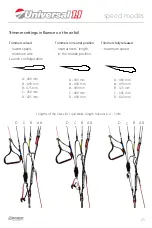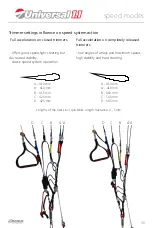
Spiral dive
Universal 1.1 is an agile paraglider, so it enters spiral dive very
quickly and can surprise the less experienced pilot.
A spiral is characterised by reaching the highest sink rates possible.
Significant G-forces, however, make it difficult to sustain a spiral
dive for a long time, as it can place high loads on both pilot and
glider to degree of losing consciousness by the pilot. Never do this
manoeuvre in turbulence or at too high bank angles.
Control the dive and do not exceed 16 m/s sink. If the dive is not
stopping after releasing the brake, assist the glider with the outer
one.
Caution:
Never execute manoeuvres generating high G-
forces (spiral dive, dynamic wimgovers etc.) on released
trimmers, as this is very dangerous!
Releasing the trimmers shifts the loading centre of the
canopy forward, toward leading edge. This rule affects all
paragliders, but the more reflex is present in the airfoil, the
more aggressive is that effect.
A typical reflex paraglider on released trimmers shows following
load distribution according to line rows: A=60%, B=30%, C=5%,
D=5%.
Taking over as much of the load by the A and B rows of the reflex
canopies (90% in total) brings about their praised stability.
However, in connection with a dynamic manoeuvre which a spiral
dive is, it can shift the load dangerously close to its maximum value.
Similar situation occurs when executing spirals or wingovers with
big ears pulled. That’s another example of concentrating whole
load on reduced wing area, which - combined with high G
manoeuvres - shifts the peak loads unnecesarily close to their
maximum values.
Wing over
You make a wingover by performing a series of consecutive,
alternating turns with growing bank angle.
Too aggressive banking with unsufficient control can result with a
massive collapse.
34
!
quick descent methods
Summary of Contents for Universal 1.1 23
Page 1: ...user manual V 07 07 2018 BASIC risers ...
Page 46: ...46 rigging scheme ...








































